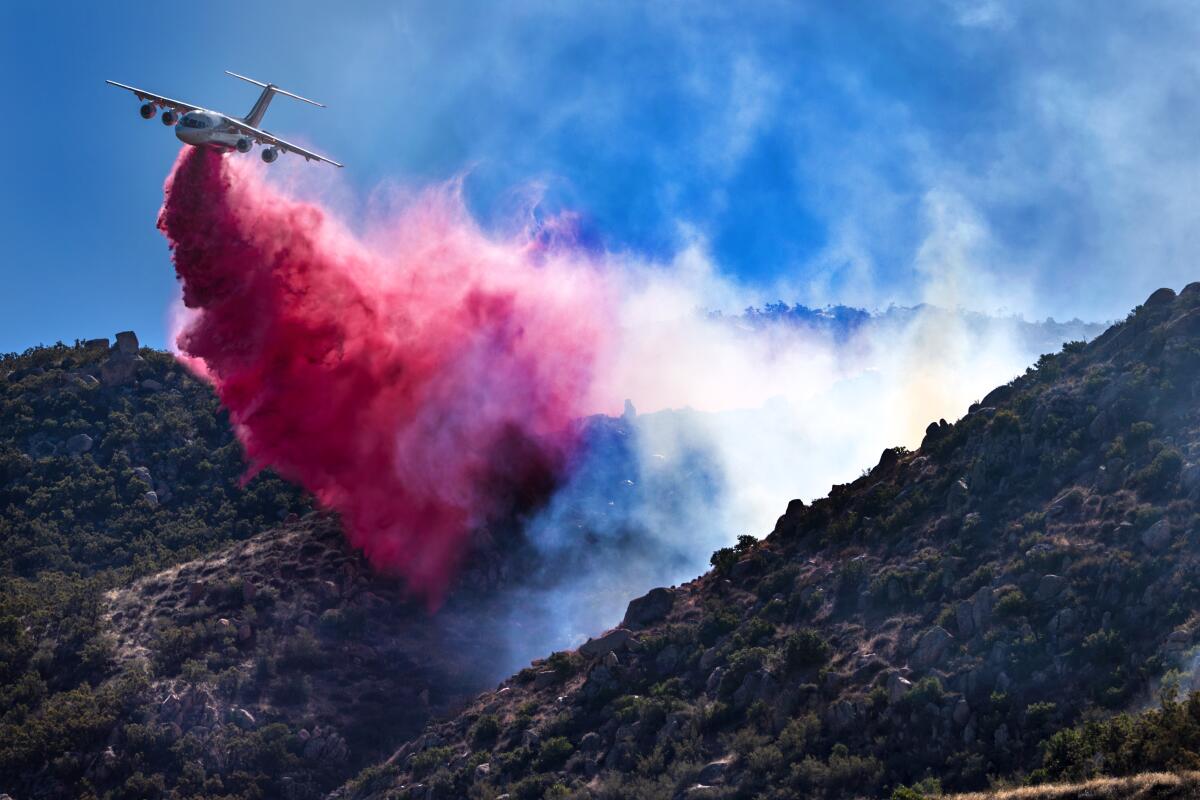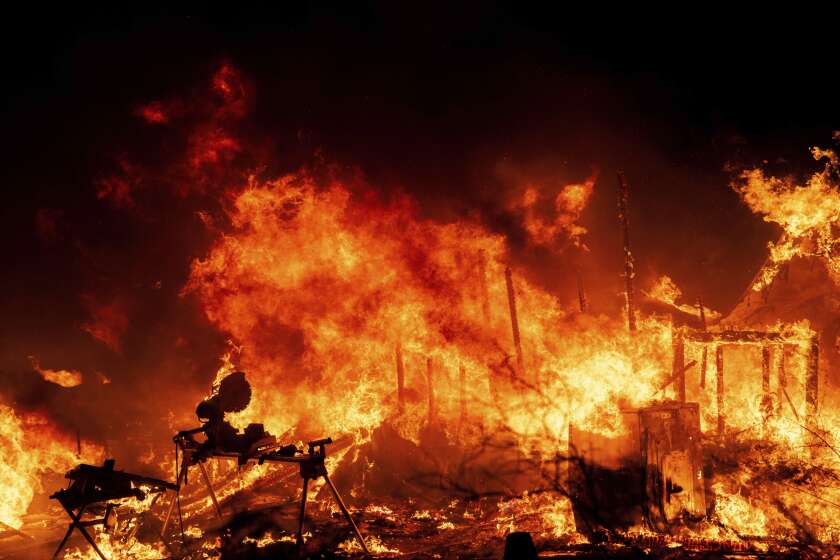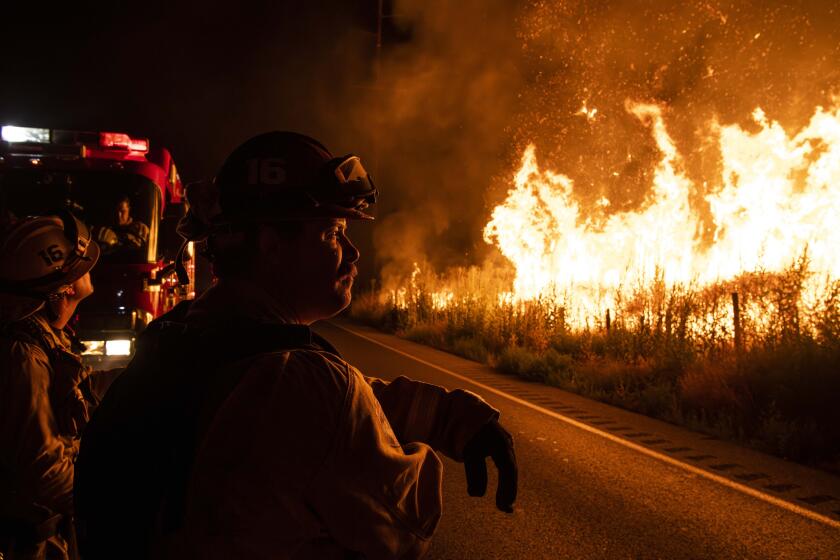Highland fire forced residents to flee. ‘I went outside and couldn’t breathe’

- Share via
A bright orange hue enveloped Carol Rogers’ neighborhood as she fled from her home in Aguanga on Monday afternoon.
Nearby, the burgeoning Highland fire was chewing through dried grasses as hot Santa Ana winds whipped it into a blaze. Rogers tried to gather her important documents, medicine and laptop but couldn’t think clearly and left with the clothes she was wearing and her slippers.
“I didn’t realize it was that bad until I went outside and couldn’t breathe,” Rogers said. “Nobody came to tell us.”
By Tuesday night, the Riverside County fire had exploded to 2,487 acres with 10% containment, according to the California Department of Forestry and Fire Protection. About 4,000 people were under mandatory evacuation orders, and at least three homes had been destroyed. Six other structures had been damaged, and an estimated 2,356 were threatened by the fire, Cal Fire reported.
More than 1,100 firefighters were attacking the fire from the air and the ground, the department reported at 7 p.m. Tuesday, but with more dry conditions and 50 mph wind gusts in the forecast, they faced an uphill battle.
“We’re looking at single-digit humidity this afternoon,” said Philip Gonsalves, a meteorologist with the weather service in San Diego, which includes Riverside County in its coverage area. “From a weather perspective, conditions are favorable for fire growth.”
In total, 1,139 homes remain under evacuation orders, and 489 homes under an evacuation warning, Cal Fire officials said.
“We just ask that the public please remain vigilant,” public information officer Maggie Cline De La Rosa said in a video update. “If you received an evacuation order, please leave. If you received an evacuation warning, please continue to pay close attention to those.”
Though a Red Cross reception center was opened at Great Oak High School in Temecula, many residents of the unincorporated area opted to decamp to the nearby parking lots of Walmart, CVS and the Pechanga Resort in their RVs.
“You gotta treat it like a holiday. What else are ya gonna do?” said Yvonne LeMay as she leaned against a lawn chair in front of Walmart, soot drizzling from the sky. “We’ve got RVs. We’ve been doing it for 20 years.”
“Well, I’m not used to it,” shot back her friend, Tracy Anderson, who leaned against her white truck to hide from the sizzling sun.
Anderson said she checked into a Holiday Inn Express and recognized others from their community. She was eager to return to her home — and a very hungry cat she couldn’t get in time — but knew she needed a distraction to keep her mind off it.
A wildfire broke out near the town of Aguanga in Riverside County on Monday, burning more than 1,200 acres and causing evacuations and road closures.
The fire was burning in an area that only recently was saturated by Tropical Storm Hilary, a rare storm that tore through swaths of Southern California in August. Gonsalves, of the weather service, said the storm’s rainfall contributed to “green-up” in the area, or the growth of new grasses, which may have subsequently dried out and could be feeding the fire.
It’s something experts warned of in the weeks after Hilary made landfall. Nick Schuler, Cal Fire’s deputy director of communications and emergency incident awareness, said in September that fire season was not over and that a prolonged wind event could still fan a blaze.
“When you have Santa Ana winds — winds that come from the east and blow to the west — it dries everything out,” Schuler said. “If you look at some of the largest fires in California’s history, especially Southern California, they started later in the year.”
Indeed, Santa Ana winds have driven many major fires in Southern California, said Luca Carmignani, a University of California Cooperative Extension wildfire advisor based at the UC South Coast Research and Extension Center in Irvine. The winds originate inland, gaining speed, warming up and drying out as they move from higher to lower elevations and squeeze through narrow canyons and passes.
Ignitions that occur without wind or dryness can usually be managed, but strong winds make it easy for flames to propagate to the rest of the vegetation.
“It’s like blowing on a barbecue — you invigorate the flames, you invigorate the combustion process so the fire can spread much, much better and faster,” Carmignani said.
He said it’s not yet clear whether growth from this year’s storms directly contributed to the spread of the Highland fire but noted that Southern California, where most of the state’s large fires have taken place this year, is characterized by shrublands.
“These plants tend to burn completely when they burn, and their natural regimen is to have less frequent fires,” he said. “So a fire happens on a less regular basis, but when they happen, they tend to burn the vegetation more intensely.”
Rob Roseen, a public information officer with Cal Fire in Riverside, said Tuesday that the Highland fire was burning in light grasses and medium brush. Remote mountaintop cameras in the area showed billowing plumes of white smoke.
“We’ll have an increased augmentation of ground resources today,” Roseen said. “They’ll be bolstered by numerous resources that will be working in the area, as well as our fixed-wing and helicopter assets that will be working over the fire throughout the day to try to build some containment on this.”
Roseen could not immediately confirm what types of structures had been destroyed. The cause of the fire remains under investigation, he said.
But the dry, windy conditions fueled several other small fires across the state, including the Lizzie fire in San Luis Obispo, which was 35% contained at 100 acres Tuesday. Crews in San Diego were also battling a small brush fire near Interstate 805 in Kearny Mesa.
In the unincorporated area of Aromas, on the border of San Benito and Monterey counties, a small fire ignited around 2 a.m. Tuesday and prompted brief evacuation orders. The fire was contained to a small water district maintenance yard, officials said.
Recent storms have dampened conditions but have also spurred new vegetation that could act as fuel for fires. Also, strong fall winds have yet to arrive.
The Highland fire was proving harder to fight.
Lona Miller said her father and stepmother, George and Luci Boyles, lost their house to the blaze on Monday. Fifteen years ago, they bought their 10-acre property located about a mile off of Highway 371; they had just paid it off two months ago, Miller said.
George called his daughter as the flames were moving in. He was able to escape with a few items and his seven dogs but not much else, Miller said. Before he left, he snapped a photo of the house ablaze, and he believes there is nothing left.
“He’s like, ‘I don’t know what to do — I’ve never been in this situation,’ ” Miller said of her father. “All they were able to grab was a couple of clothes, my sister’s ashes and the dogs. They have five cats, but they’re indoor-outdoor and he couldn’t get ahold of them so we don’t know if they made it. He had to open up his chicken coop and shoo all the chickens out. He’s like, ‘I don’t know what’s left up there, but the house was completely on fire.’ ”
Rogers, the Aguanga resident who fled in her slippers Monday afternoon, said she believed her home was still standing, but she wasn’t sure how livable it would be. Drone footage she saw from another person camped in the Walmart lot showed her whole area was pitch black.
“It’s been the worst one. It came through so fast and so close,” she said.
An array of packaged baked goods were scattered in her vehicle. As winds picked up, her throat started to itch. Rogers hadn’t worked at her Smog Check business for the past month because she had a lung removed in June and was advised by her physical therapist to try not to breathe in any toxins. She chuckled at the situation she was in.
“I’m going to sit here and hope they open up the freeway,” she said. “There’s nothing really else to do.”










